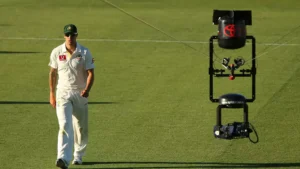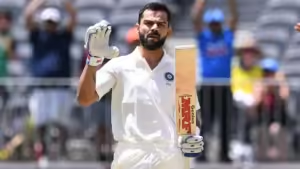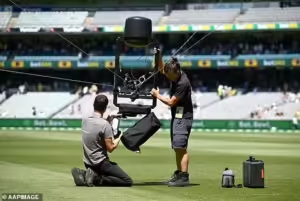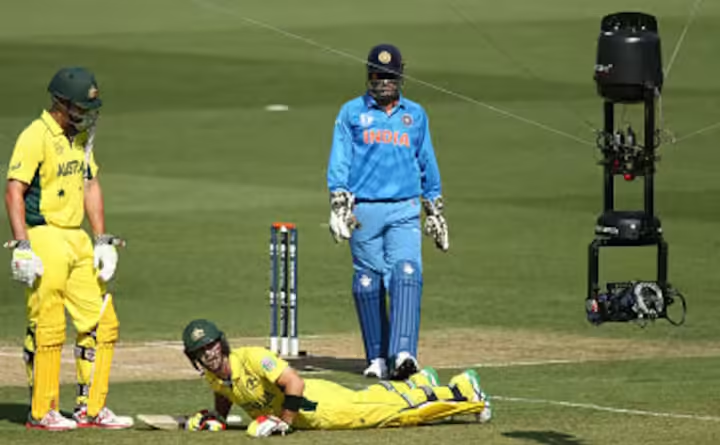Spidercam: A Game Changer that Bringing Cricket Closer to Fans
With its rich history and traditions, Cricket has always been open to embracing new technologies to enhance fans’ viewing experience worldwide. One such innovation is the Spidercam, a camera system that provides breathtaking aerial views of the action on the field. In this blog, we’ll dive into the workings of the Spidercam, its impact on cricket, and some unique moments it has captured.
What is Spidercam?
Spidercam is an advanced camera system that operates on a series of cables suspended above the playing field. It can move horizontally and vertically, offering a bird’s-eye view of the stadium.

The technology behind Spidercam involves four motorized winches placed at the corners of the ground, connected by Kevlar cables to a gyro-stabilized camera platform. This setup allows the camera to move seamlessly in three dimensions, controlled remotely by a skilled operator.
How Does Spidercam Work?
The operation of Spidercam involves several key components:
Winches and Cables: Four motorized winches are installed at the corners of the stadium. These winches control the tension and movement of the Kevlar cables that support the camera. The cables are robust yet lightweight, ensuring stability and flexibility.
Camera Platform: The camera is mounted on a gyro-stabilized platform. This ensures the footage remains smooth and stable, even when the camera rushes. The platform can rotate 360 degrees, providing comprehensive coverage of the field.

Remote Control System: Operators control Spidercam from a remote station. Using joysticks and computer interfaces, they can adjust the camera’s position, altitude, and angle in real time. This allows for dynamic shots that follow the action closely.
Data Transmission: High-definition video signals from the camera are transmitted wirelessly to the broadcasting station. This real-time transmission ensures that viewers receive live, uninterrupted footage.
Impact on Cricket Broadcasting:
Spidercam has revolutionized cricket broadcasting in several ways:
- Enhanced Viewing Experience: The aerial perspective provided by Spidercam offers a unique vantage point that traditional ground-based cameras cannot achieve. Viewers can appreciate the strategic positioning of fielders, the trajectory of the ball, and the overall layout of the field.
- Dramatic Visuals: Spidercam captures dramatic visuals that add to the excitement of the game. For instance, close-up shots of players during critical moments, aerial views of the pitch, and sweeping shots of the stadium create a cinematic experience for fans.
- Improved Analysis: Analysts and commentators benefit from Spidercam’s footage, as it allows them to dissect plays from different angles. This detailed analysis can enhance the understanding of complex strategies and highlight individual performances.
Unique Moments Captured by Spidercam:
Spidercam has been a part of many memorable moments in cricket. Here are a few highlights:
2015 Cricket World Cup Final: During the final between Australia and New Zealand, Spidercam provided stunning aerial views of the Melbourne Cricket Ground. The dynamic shots of Mitchell Starc’s fiery opening spell and the celebratory scenes after Australia’s victory were unforgettable.

AB de Villiers’ 360-Degree Batting: Known for his innovative and unorthodox shots, AB de Villiers‘ batting has been beautifully captured by Spidercam. During a match against the West Indies in the 2015 ICC Cricket World Cup, de Villiers smashed 162 runs off 66 balls. Spidercam’s aerial shots showcased his ability to hit the ball all around the park, giving fans a unique view of his 360-degree batting style.

Virat Kohli’s Century Against Australia (2018): During the Perth Test match, Virat Kohli scored a magnificent century, which was highlighted by Spidercam’s close-up shots of his focused expression and flawless batting technique. The camera also captured his emotional celebration, giving fans an intimate view of his passion and determination.

Carlos Brathwaite’s Four Sixes in the T20 World Cup Final (2016): In the final over of the T20 World Cup, Carlos Brathwaite hit four consecutive sixes to secure victory for the West Indies against England. Spidercam provided exhilarating footage of each six, showing the trajectory of the ball and the crowd’s ecstatic reactions.

Eoin Morgan’s Record-Breaking Innings (2019): In a World Cup match against Afghanistan, Eoin Morgan hit a record 17 sixes in his innings of 148 runs. Spidercam’s aerial shots provided a comprehensive view of the ball sailing into the stands repeatedly, creating an unforgettable visual spectacle.

Technical Challenges and Innovations:
While Spidercam offers numerous benefits, it also presents technical challenges:
- Weather Conditions: Adverse weather conditions, such as strong winds or rain, can affect the stability of Spidercam. Engineers have developed advanced stabilization systems to mitigate these effects, ensuring smooth footage even in less-than-ideal conditions.
- Cable Management: Managing the tension and movement of the cables is crucial for the safe and effective operation of Spidercam. Continuous monitoring and adjustments are required to maintain optimal performance.
- Integration with Other Technologies: Spidercam often needs to work in conjunction with other broadcast technologies, such as ultra-high-definition cameras and real-time analytics tools. Seamless integration of these systems is essential for delivering a cohesive viewing experience.
Future Prospects of Spidercam in Cricket:
The future of Spidercam in cricket looks promising, with potential innovations on the horizon:

- Augmented Reality (AR): Integrating AR elements with Spidercam footage could provide real-time stats and visual aids for viewers. For instance, displaying the distance covered by a fielder or the speed of a bowler’s delivery can enhance the understanding of the game.
- AI-Driven Automation: Advances in artificial intelligence could lead to partially automated control of Spidercam. AI algorithms could predict player movements and adjust the camera’s position accordingly, providing even more precise and dynamic footage.
- Expanded Use in Other Sports: While Spidercam is already used in various sports, its application could expand further. Enhanced versions of Spidercam could be developed for sports like rugby, American football, and even extreme sports, providing new perspectives and engaging visuals.
Conclusion:
Spidercam has undoubtedly transformed the way cricket is broadcasted, offering unique perspectives and enhancing the viewer experience. Its ability to capture dramatic moments and provide detailed analysis has made it an invaluable tool for broadcasters, analysts, and fans alike.
As technology continues to evolve, Spidercam is poised to play an even more significant role in the future of sports broadcasting, bringing fans closer to the action than ever before.
